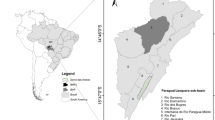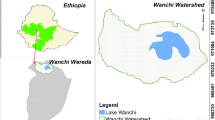Abstract
Land-use and land-cover change affects both ecological and socioeconomic processes, motivating the integration of environmental and socioeconomic data to help understand this change. In this study, we propose a method for the characterisation and spatial analysis of land use and cover change in the Upper Uruguay River Basin (Brazil) based on (i) the characterisation of six LUCC processes—degradation, regeneration, intensification, extensification, silviculture expansion and urbanisation—by the combination of 2002 and 2008 land-use and land-cover classifications of Landsat/TM imagery and on (ii) the investigation of the relationships between the LUCC processes and environmental and socioeconomic variables via the combination of canonical correspondence analysis, linear and local spatial regression models (OLS and GWR) and spatial clustering procedures (SKATER), using environmental data, including geomorphometric data, landscape metrics and census socioeconomic statistics. The LUCC processes could be explained in terms of the associations between the selected physical, ecological and social variables that allowed the terrain, landscape fragmentation and socioeconomic characteristics to be related to various LUCC processes.







Similar content being viewed by others
References
Alves DS (2012) Two cultures, multiple theoretical perspectives: the problem of integration of natural and social sciences in earth system research. In: Young SS, Silvern SE (eds) International perspectives on environmental global change. InTech, Rijeka
Anselin L (2002) Under the hood: issues in the specification and interpretation of spatial regression models. Agric Econ 27:247–267
Assunção RM, Neves MC, Câmara G, Freitas CC (2006) Efficient regionalization techniques for socio-economic geographical units using minimum spanning trees. Int J Geogr Inf Sci 20(7):797–811
Batistella M, Valladares GS (2009) Farming expansion and land degradation in Western Bahia, Brazil. Biotaneotropica 9(3):61–76
Bivand R (2011) Spatial dependence: weighting schemes; statistics and models. R package version 0.5-40. Available online at: http://cran.r-project.org/web/packages/spdep/spdep.pdf. Accessed 19 Oct 2011
Bivand R, Yu D (2011). spgwr: Geographically weighted regression. R package version 0.6-13. Available online at: http://cran.r-project.org/web/packages/spgwr/spgwr.pdf. Accessed 19 Oct 2011
Braak CJF (1986) Canonical correspondence analysis: a new eigenvector method for multivariate direct gradient analysis. Ecology 67:1167–1179
Buyantuyev A, Wu J (2010) Urban heat islands and landscape heterogeneity: linking spatiotemporal variations in surface temperatures to land-cover and socioeconomic patterns. Landscape Ecol 25(1):17–33
Chevan A, Sutherland M (1991) Hierarchical partitioning. Am Stat 45(2):90–96
Cliff AD, Ord JK (1981) Spatial processes: models and applications. Pion, London
Cunha MCL, Monguilhott M, Saldanha DL, Guasselli LA, Pereira G (2011) Quantificação da dinâmica dos remanescentes florestais no Município de Jaquirana, RS, em imagens de satélite. Rev Árvore 35(4):867–873
DEFINIENS (2007) Definiens Developer 7 reference book. Definiens AG, Munich
ESRI (2011) ArcGIS desktop: release 10. Environmental Systems Research Institute, Redlands
Evans IS (1972) General geomorphometry, derivations of altitude and descriptive statistics. In: Chorley RJ (ed) Spatial analysis in geomorphology. Methuen, London
Farina A (1998) Principles and methods in landscape ecology. Chapman & Hall, London
Fotheringham AS, Brunsdon C, Charlton M (2002) Geographically weighted regression: the analysis of spatially varying relationships. Wiley, Chichester
Fox J, Rindfuss RR, Walsh S, Mishra V (2003) People and the environment: approaches for linking household and community surveys to remote sensing and GIS. Kluwer, Norwell
Grohmann CH, Smith MJ, Riccomini C (2011) Multiscale analysis of topographic surface roughness in the Midland Valley, Scotland. IEEE T Geosci Remote 49(4):1200–1213
Hietel E, Waldhardt R, Otte A (2004) Analysing land-cover changes in relation to environmental variables in Hesse, Germany. Landscape Ecol 19(5):473–489
Hudson WD, Ramm CW (1987) Correct formulation of the kappa coefficient of agreement. Photogram Eng Remote Sens 53:421–422
IBGE (2000) Censo demográfico: resultados do universo. IBGE, Rio de Janeiro
Kupfer JA, Farris CA (2007) Incorporating spatial non-stationarity of regression coefficients into predictive vegetation models. Landscape Ecol 22(6):837–852
Lepš J, Smilauer P (2003) Multivariate analysis of ecological data using CANOCO. Cambridge University Press, Cambridge
Lesschen JP, Verburg PH, Staal SJ (2005) Statistical methods for analyzing the spatial dimension of changes in land use and farming systems. The International Livestock Research Institute/LUCC Focus 3 Office, Nairobi/Wageningen
Leung Y, Mei CL, Zhang WX (2000) Testing for spatial autocorrelation among the residuals of the geographically weighted regression. Environ Plan A 32(5):871–890
Liverman DM, Cuesta RMR (2008) Human interactions with the Earth system: people and pixels revisited. Earth Surf Proc Land 33:1458–1471
Liverman DM, Moran EF, Rindfuss RR, Stern PC (eds) (1998) People and pixels, linking remote sensing and social science. National Academy Press, Washington
Lloyd CD (2011) Local models for spatial analysis. CRC Press, Boca Raton
Machado LO (1998) A fronteira agrícola na Amazônia brasileira. In: Christofoletti A et al (eds) Geografia e Meio Ambiente no Brasil. Hucitec, São Paulo
Matricardi EAT, Skole DL, Pedlowski MA, Chomentowski W, Fernandes LC (2010) Assessment of tropical forest degradation by selective logging and fire using Landsat imagery. Remote Sens Environ 114(5):1117–1129
McGarigal K, Marks BJ (1995) Fragstats: spatial pattern analysis program for quantifying landscape structure. US Department of Agriculture, Portland
Meyer WB, Turner BL II (1992) Human population growth and global land-use/cover change. Ann Rev Ecol Syst 23:39–61
Munyati C, Makgale D (2009) Multitemporal Landsat TM imagery analysis for mapping and quantifying degraded rangeland in the Bahurutshe communal grazing lands, South Africa. Int J Remote Sens 30(14):3649–3668
Navulur K (2007) Multispectral image analysis using object-oriented paradigm. CRC Press, Boca Raton
Neter J, Kutner MH, Wasserman W, Nachtscheim CJ (1996) Applied linear regression models. McGraw-Hill College, New York
Olofsson P, Foody GM, Stehman SV, Woodcock CE (2013) Making better use of accuracy data in land change studies: estimating accuracy and area and quantifying uncertainty using stratified estimation. Remote Sens Environ 129:122–131
Overmars KP, Koning GHJ, Veldkamp A (2003) Spatial autocorrelation in multi-scale land use models. Ecol Model 164(2–3):257–270
R Development Core Team (2008) R: A language and environment for statistical computing. R Foundation for Statistical Computing, Vienna
Shimabukuro YE, Smith JA (1991) The least-square mixing models to generate fraction images derived from remote sensing multispectral data. IEEE T Geosci Remote 29(1):16–20
Soares-Filho BS, Garcia RA, Rodrigues H, Moro S, Nepstad D (2008) Nexos entre as dimensões socioeconômicas e o desmatamento: a caminho de um modelo integrado. In: Batistella M et al (eds) Amazônia: natureza e sociedade em transformação. Edusp, São Paulo
Sturges HA (1926) The choice of a class interval. J Am Stat Assoc 21(153):65–66
Valbuena D, Verburg PH, Bregt AK, Ligtenberg A (2010) An agent-based approach to model land-use change at a regional scale. Landscape Ecol 25(2):185–199
Valeriano MM, Rosseti DF (2011) Topodata: Brazilian full coverage refinement of SRTM data. Appl Geogr 32(2):300–309
Vannier C, Vasseur C, Hubert-Moy L, Baudry J (2011) Multiscale ecological assessment of remote sensing images. Landscape Ecol 26(8):1053–1069
Verburg PH (2006) Simulating feedbacks in land use and land cover change models. Landscape Ecol 21(8):1171–1183
Walsh C, MacNally R (2011) Hierarchical partitioning. R package version 1.0-3. Available online at: http://cran.r-project.org/web/packages/hier.part/hier.part.pdf. Accessed 20 Oct 2011
Author information
Authors and Affiliations
Corresponding author
Rights and permissions
About this article
Cite this article
de Freitas, M.W.D., Santos, J.R.d. & Alves, D.S. Land-use and land-cover change processes in the Upper Uruguay Basin: linking environmental and socioeconomic variables. Landscape Ecol 28, 311–327 (2013). https://doi.org/10.1007/s10980-012-9838-9
Received:
Accepted:
Published:
Issue Date:
DOI: https://doi.org/10.1007/s10980-012-9838-9




